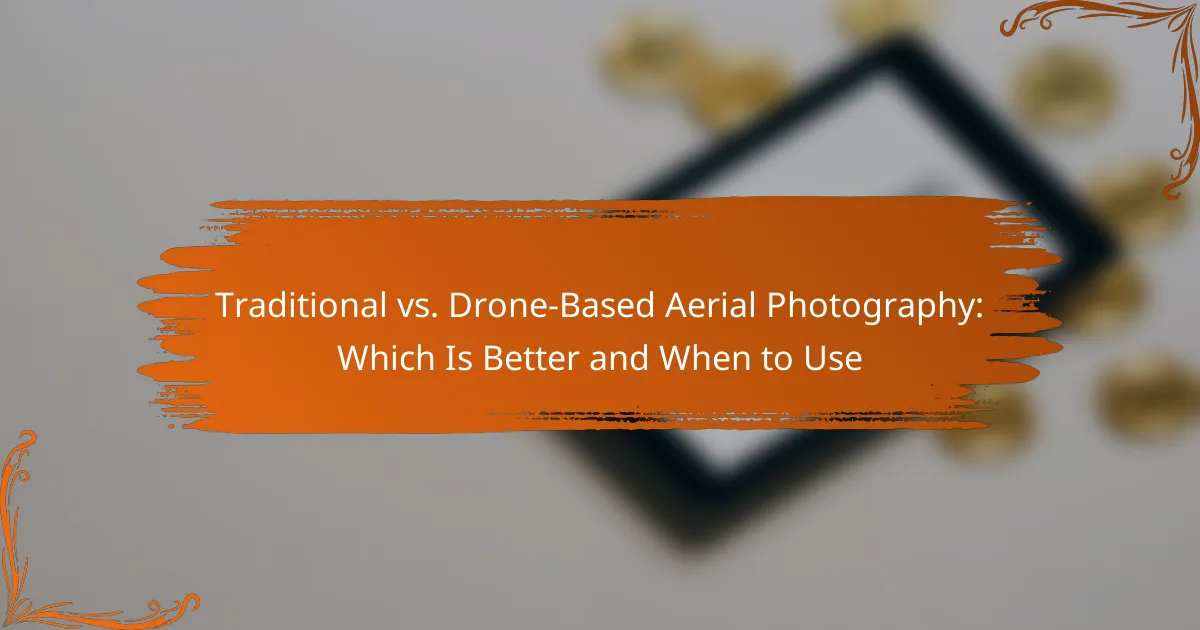When it comes to aerial photography, choosing between traditional methods and drone-based techniques depends on the specific needs of the project. Traditional aerial photography excels in delivering high-resolution images and adhering to regulatory standards, making it suitable for industries like real estate and construction. In contrast, drone-based photography offers quick access to unique perspectives and is often more cost-effective for capturing landscapes and events. Understanding the strengths of each approach can help you determine the best option for your aerial imaging needs.
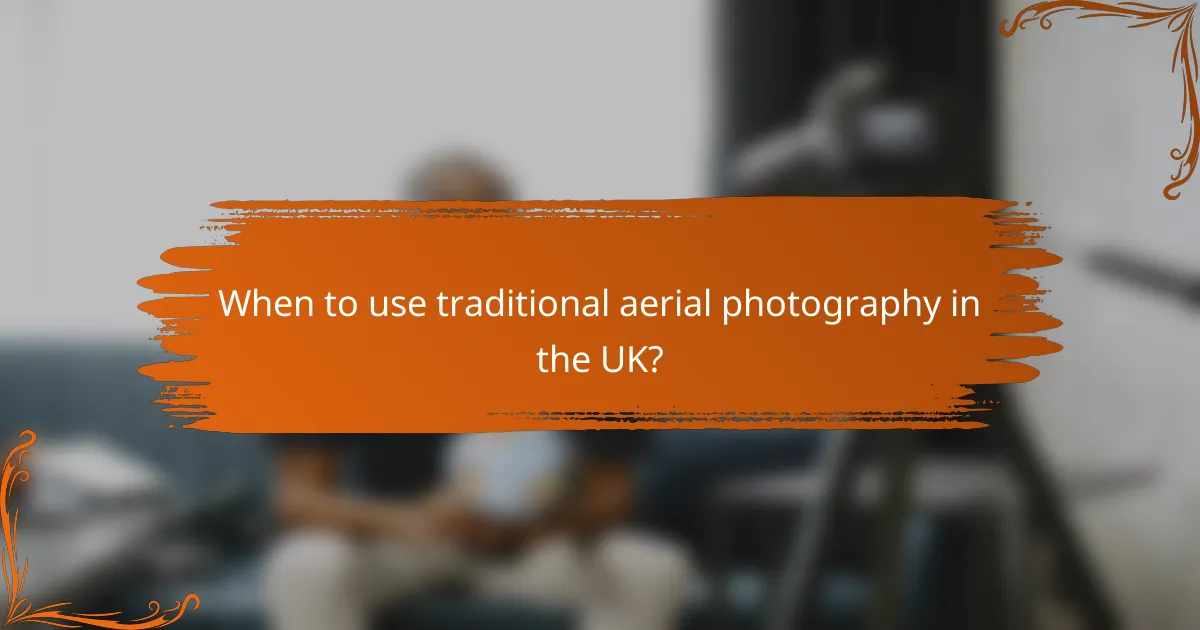
When to use traditional aerial photography in the UK?
Traditional aerial photography is ideal for projects requiring high-resolution images, compliance with specific regulations, or large-scale coverage. It is often used in industries such as real estate, construction, and environmental monitoring where detail and regulatory adherence are crucial.
High-resolution imagery
Traditional aerial photography typically provides higher resolution images compared to drone-based methods, making it suitable for detailed analysis. This is particularly important in fields like surveying or mapping, where clarity can significantly impact decision-making.
For example, traditional methods can capture images with resolutions exceeding 100 megapixels, which is beneficial for applications like land-use planning or heritage documentation. When detail is paramount, traditional aerial photography is often the preferred choice.
Specific regulatory compliance
In the UK, traditional aerial photography is often more compliant with regulations governing airspace and privacy. For projects that require adherence to strict guidelines, such as those involving sensitive areas or historical sites, traditional methods can navigate these complexities more effectively.
Additionally, traditional aerial photography is less likely to face restrictions that drones might encounter, such as no-fly zones or altitude limits. This makes it a reliable option for obtaining necessary permissions and ensuring compliance with local laws.
Large-scale projects
For large-scale projects, traditional aerial photography can cover extensive areas more efficiently than drones. This is particularly useful in sectors like agriculture, forestry, and urban planning, where vast landscapes need to be documented.
Using manned aircraft can facilitate the capture of comprehensive imagery in a single flight, reducing the time and resources needed compared to multiple drone flights. When planning large projects, consider traditional aerial photography for its ability to deliver broad coverage with high detail.
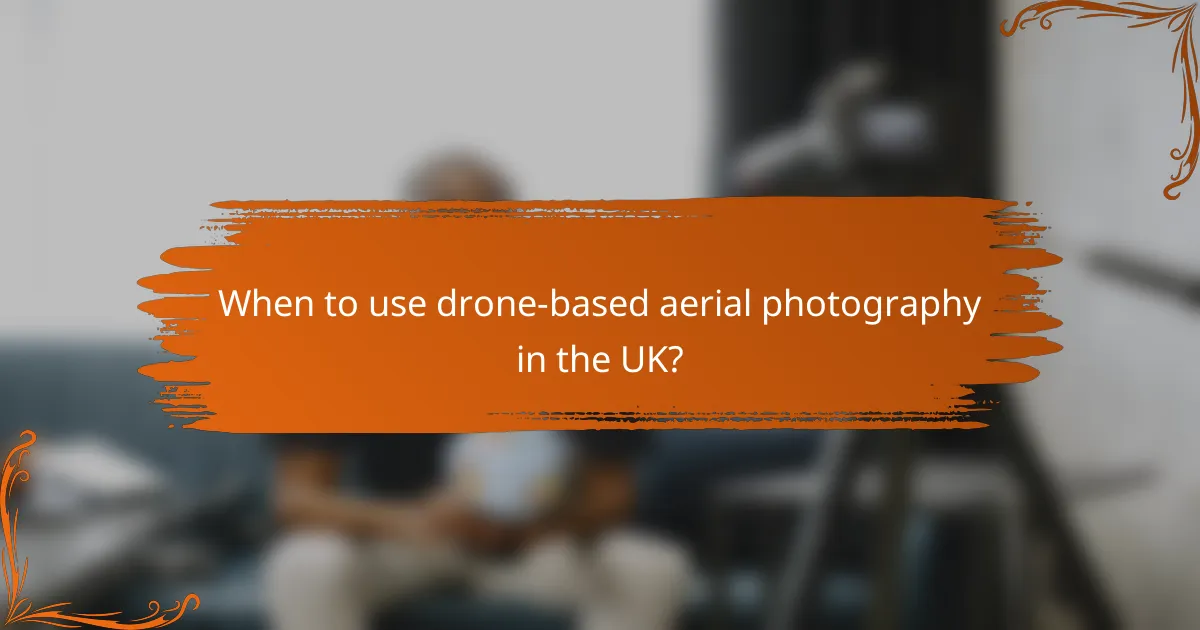
When to use drone-based aerial photography in the UK?
Drone-based aerial photography is ideal for projects requiring quick, high-quality images from unique perspectives. It is particularly useful in the UK for capturing landscapes, real estate, and events where traditional methods may be impractical or costly.
Cost-effective for small projects
Drone photography can significantly reduce costs for small projects compared to traditional aerial photography, which often involves hiring helicopters or planes. For budgets in the low hundreds to low thousands of pounds, drones provide a viable alternative without sacrificing quality.
When considering costs, factor in the potential savings on equipment rental and operational expenses. Drones can cover areas quickly, minimizing labor costs and time spent on-site.
Flexibility in capturing angles
Drones offer remarkable flexibility in capturing a variety of angles and perspectives that traditional methods may struggle to achieve. They can easily maneuver around obstacles and fly at different altitudes to obtain the desired shots.
This adaptability is particularly beneficial for real estate photography or surveying land, where specific angles can highlight features that are crucial for marketing or analysis.
Rapid deployment
One of the key advantages of drone-based aerial photography is its rapid deployment capability. Drones can be set up and in the air within minutes, allowing for quick assessments or documentation of events and sites.
This speed is essential for time-sensitive projects, such as capturing construction progress or documenting changes in landscapes due to environmental factors. Quick turnaround times can enhance project efficiency and responsiveness.
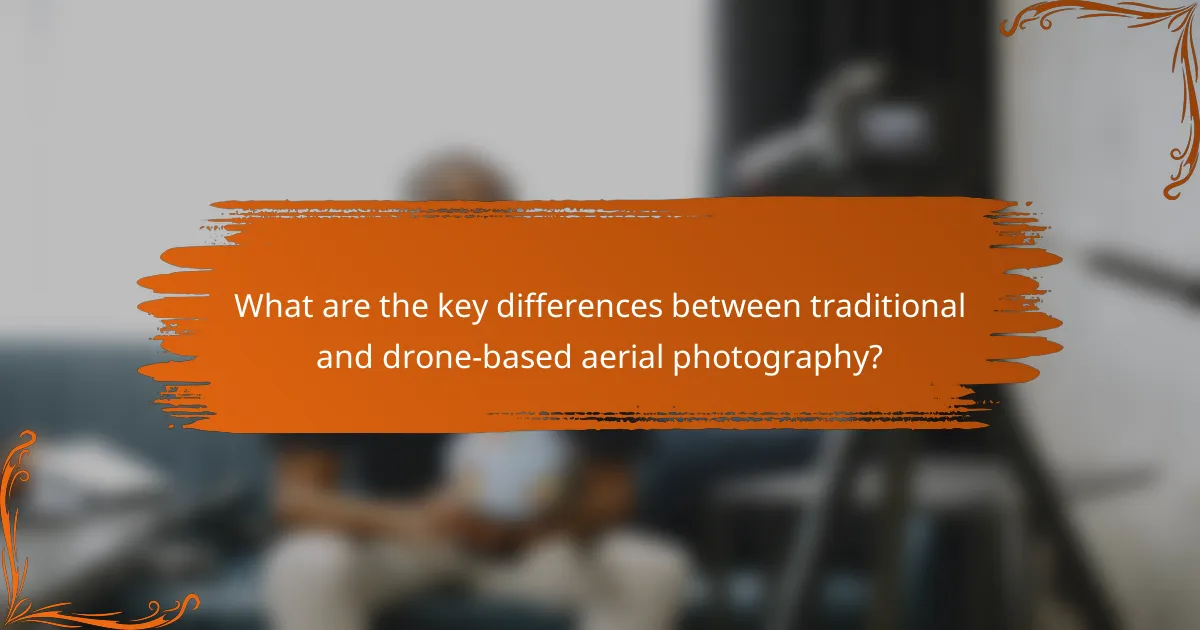
What are the key differences between traditional and drone-based aerial photography?
Traditional aerial photography typically involves manned aircraft, while drone-based aerial photography utilizes unmanned aerial vehicles (UAVs). Each method has unique advantages and limitations that make them suitable for different scenarios.
Equipment and technology
Traditional aerial photography relies on larger aircraft equipped with high-end cameras and stabilization systems. This setup is often more complex and requires trained pilots and crew. In contrast, drone-based photography uses compact drones that can be operated remotely, allowing for greater flexibility and ease of use.
Modern drones come equipped with advanced technology, including GPS, obstacle avoidance, and high-resolution cameras. This technology enables drones to capture images from various angles and altitudes, making them ideal for detailed surveys and inspections.
Cost comparison
The cost of traditional aerial photography can be significantly higher due to the expenses associated with aircraft operation, fuel, and pilot fees. Prices can range from hundreds to thousands of dollars per flight, depending on the complexity and duration of the shoot.
Drone-based aerial photography is generally more affordable, with costs often in the low hundreds of dollars for a session. This makes drones a popular choice for small businesses and individual projects, allowing for high-quality images without the hefty price tag.
Image quality and resolution
Image quality in traditional aerial photography can be exceptional, particularly when using high-end cameras mounted on stable platforms. These setups can achieve resolutions that are difficult to match with consumer-grade drones.
However, advancements in drone technology have led to significant improvements in image quality. Many drones now offer 4K resolution and even higher, making them suitable for professional use. When selecting between the two, consider the specific requirements of your project, such as the level of detail needed and the shooting conditions.
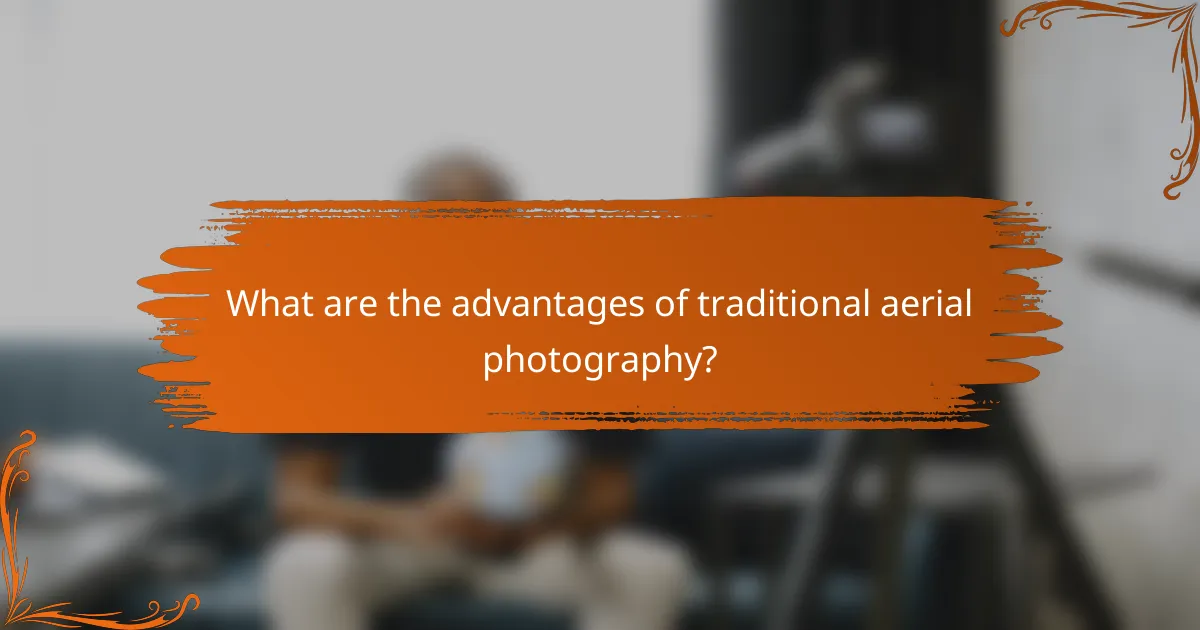
What are the advantages of traditional aerial photography?
Traditional aerial photography offers several advantages, particularly in terms of image quality and reliability. It typically involves using manned aircraft, which can provide superior resolution and stability compared to drone-based methods.
Higher image resolution
Traditional aerial photography often achieves higher image resolution due to the larger sensors used in manned aircraft. These sensors can capture more detail, making them ideal for applications like mapping, surveying, and high-quality commercial photography.
For instance, a traditional aerial image can have resolutions in the range of 5 to 10 centimeters per pixel, which is significantly better than many consumer drones. This level of detail is crucial for projects requiring precise measurements or detailed visual analysis.
Stability in adverse weather
Manned aircraft are generally more stable in adverse weather conditions compared to drones. They can operate effectively in wind, rain, and varying temperatures, making them suitable for capturing images in diverse environments.
For example, traditional aerial photography can continue during light rain or moderate winds, while drones may be grounded due to safety concerns. This reliability allows for more flexibility in scheduling and project execution.
Longer flight times
Traditional aerial photography benefits from longer flight times, as manned aircraft can remain airborne for several hours. This extended duration allows for comprehensive coverage of large areas without the need for frequent battery changes or refueling.
In contrast, most consumer drones typically have flight times ranging from 20 to 30 minutes. For large-scale projects, this can necessitate multiple flights, increasing time and operational costs. Traditional methods can streamline the process, making them more efficient for extensive aerial surveys.
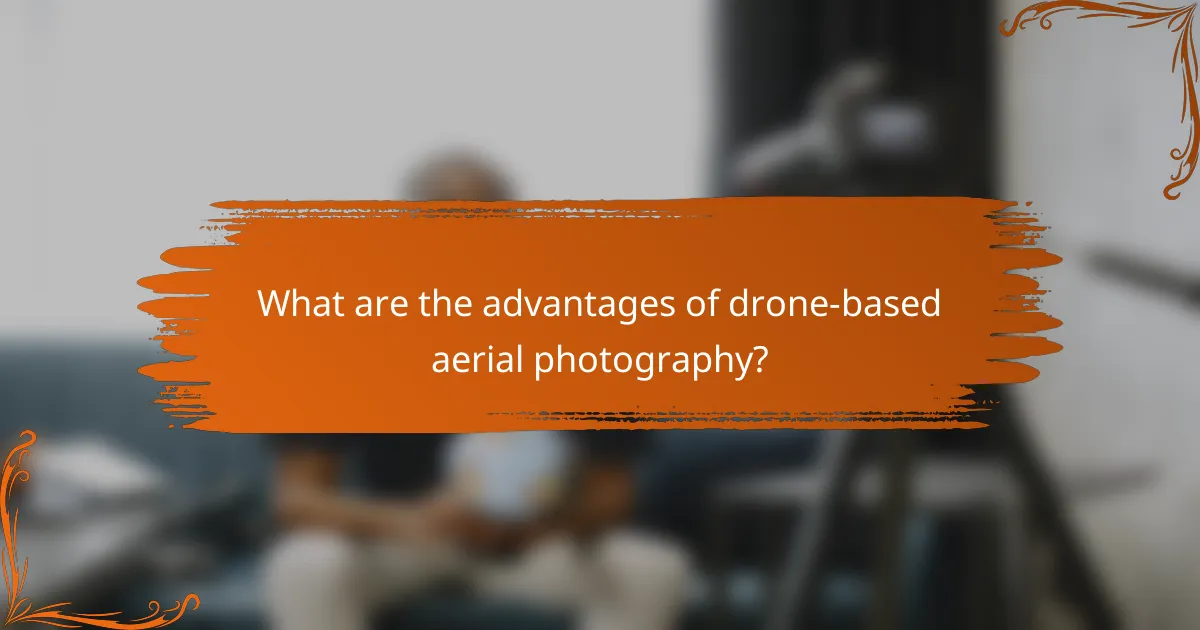
What are the advantages of drone-based aerial photography?
Drone-based aerial photography offers several advantages over traditional methods, primarily in cost, accessibility, and efficiency. Drones can capture high-quality images quickly and at a fraction of the cost of manned aircraft, making them an attractive option for various applications.
Lower operational costs
Drone aerial photography typically incurs lower operational costs compared to traditional methods. The expenses associated with hiring a pilot, fuel, and aircraft maintenance can significantly increase the budget for aerial photography projects. Drones, on the other hand, require minimal investment and can be operated by a single individual.
For example, while a manned aircraft might cost thousands of dollars per hour, a drone can be operated for a few hundred dollars, depending on the complexity of the project. This cost-effectiveness makes drones ideal for real estate, agriculture, and surveying, where budgets may be tight.
Accessibility to hard-to-reach areas
Drones excel in accessing areas that are difficult or dangerous for traditional aircraft to reach. They can easily navigate tight spaces, rugged terrain, and urban environments, capturing images that would otherwise be impossible or risky to obtain.
For instance, in construction or environmental monitoring, drones can fly over obstacles like buildings or dense forests, providing valuable data without the need for extensive ground crews. This capability not only enhances safety but also improves the quality and scope of the aerial imagery collected.






